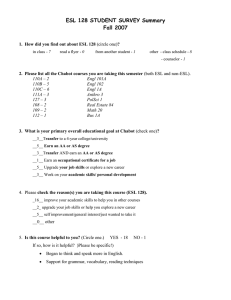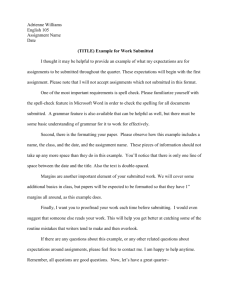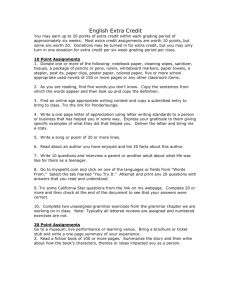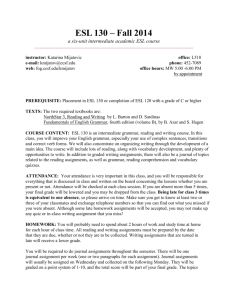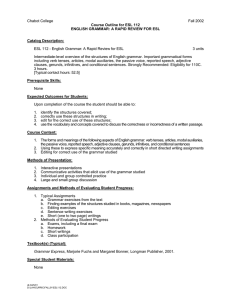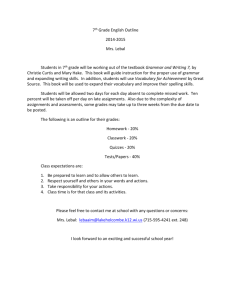College of San Mateo Course Outline
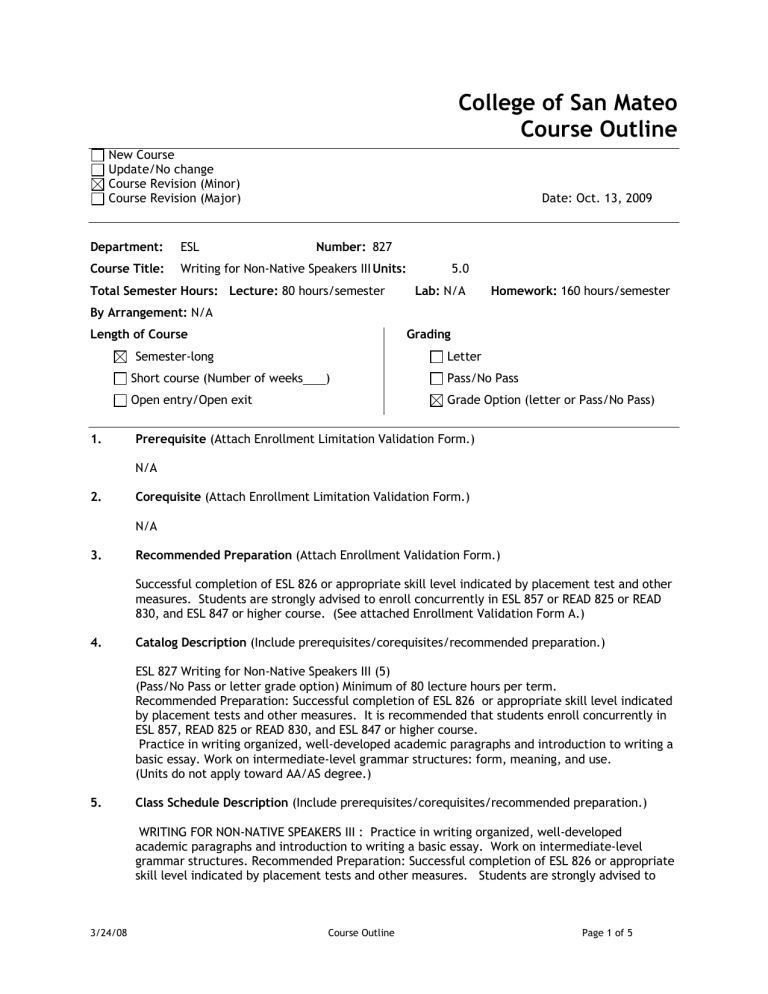
College of San Mateo
Course Outline
New Course
Update/No change
Course Revision (Minor)
Course Revision (Major)
Department: ESL Number: 827
Course Title: Writing for Non-Native Speakers III Units:
Date: Oct. 13, 2009
5.0
Total Semester Hours: Lecture: 80 hours/semester Lab: N/A Homework: 160 hours/semester
By Arrangement: N/A
Length of Course
Semester-long
Short course (Number of weeks )
Open entry/Open exit
1.
2.
N/A
Grading
Letter
Pass/No Pass
Prerequisite (Attach Enrollment Limitation Validation Form.)
Corequisite (Attach Enrollment Limitation Validation Form.)
Grade Option (letter or Pass/No Pass)
N/A
3. Recommended Preparation (Attach Enrollment Validation Form.)
Successful completion of ESL 826 or appropriate skill level indicated by placement test and other measures. Students are strongly advised to enroll concurrently in ESL 857 or READ 825 or READ
830, and ESL 847 or higher course. (See attached Enrollment Validation Form A.)
4. Catalog Description (Include prerequisites/corequisites/recommended preparation.)
ESL 827 Writing for Non-Native Speakers III (5)
(Pass/No Pass or letter grade option) Minimum of 80 lecture hours per term.
Recommended Preparation: Successful completion of ESL 826 or appropriate skill level indicated by placement tests and other measures. It is recommended that students enroll concurrently in
ESL 857, READ 825 or READ 830, and ESL 847 or higher course.
Practice in writing organized, well-developed academic paragraphs and introduction to writing a basic essay. Work on intermediate-level grammar structures: form, meaning, and use.
(Units do not apply toward AA/AS degree.)
5. Class Schedule Description (Include prerequisites/corequisites/recommended preparation.)
WRITING FOR NON-NATIVE SPEAKERS III : Practice in writing organized, well-developed academic paragraphs and introduction to writing a basic essay. Work on intermediate-level grammar structures. Recommended Preparation: Successful completion of ESL 826 or appropriate skill level indicated by placement tests and other measures. Students are strongly advised to
3/24/08 Course Outline Page 1 of 5
enroll concurrently in ESL 857, READ 825 or READ 830, and ESL 847 or higher course. Pass/No
Pass or letter grade option. (Units do not apply toward AA/AS degree.)
6. Student Learning Outcomes (Identify 1-6 expected learner outcomes using active verbs.)
Upon successful completion of the course, the student will be able to:
* use intermediate grammar structures appropriately in academic paragraphs;
* write well-developed, organized academic paragraphs with a clear topic sentence, supporting ideas, and a concluding statement;
* write a basic essay with a rudimentary introductory paragraph with a clear thesis statement, welldeveloped body paragraphs, and a brief concluding paragraph;
* use reading materials, student models, and/or a short novel to build schema for writing assignments;
7. Course Objectives (Identify specific teaching objectives detailing course content and activities.
For some courses, the course objectives will be the same as the student learning outcomes. If
this is the case, please simply indicate this in this section).
Same as the Student learning Outcomes above.
8. Course Content (Brief but complete topical outline of the course that includes major subject areas [1-2 pages]. Should reflect all course objectives listed above. In addition, you may attach a sample course syllabus with a timeline.)
I. Intermediate Grammar Structures (Should be covered during the semester.)
A. Connectors
1. Coordinators (and, so, or, but)
2. Subordinators (although, because, when, while)
3. Transition words (however, therefore, moreover)
B. Gerunds and Infinitives
1. Verbs that require gerunds only
2. Verbs that require infinitives only
3. Verbs that can take both gerunds and infinitives
4. Use of gerunds or gerund phrases as subjects
5. Use of infinitives of purpose
6. Use of infinitives with too and enough
C. Comparisons
1. Comparative and superlative forms of adjectives and adverbs
2. "Comparing and contrasting words " such as more/less, as.. .as, the same as, similar to, different from,and like/alike.
D. Passive Sentences
1. Review of verb tenses
2. Active vs passive voice
3. Transitive vs intransitive verbs
E. Word Forms related to writing assignments
*Based on the needs of the class, the following intermediate grammar structures may also be taught.
F. Review of Count/Noun Count Nouns and Articles (a, an,the)
G. Introduction to Adjective Clauses
3/24/08 Course Outline Page 2 of 5
H. Introduction to Noun Clauses
II. Academic Writing Skills:
(Emphasis is on writing organized and well-developed academic paragraphs with a clear topic sentence, supporting ideas, and a concluding statement. Incorporating intermediate grammar structures in writing assignments is also emphasized. Transitioning from paragraph writing to a basic essay is introduced at this level. Basic summary skills (restating the main ideas/salient points of a reading selection and/or a chapter from a short novel) and incorporating reading materials to build schema for writing assignments are also introduced.)
Rhetorical Modes (Listed in the order of importance. May include but are not limited to the following:)
A. Description
1. Focusing on a dominant impression
2. Supporting with descriptive details
3. Organizing by spatial or physical arrangement
4. Incorporating the use of connectors
B. Narration
1. Focusing on a main point
2. Supporting the main point with background information and developing ideas
3. Organizing by chronological order
4. Incorporating the use of gerunds and infinitives
C. Compare and Contrast
1. Choosing comparable items
2. Finding points of comparison
3. Organizing by points
4. Incorporating the use of comparative and superlative forms
D. Analysis
1. Analyzing reasons and/or a process
2. Supporting reasons or giving steps in a process
3. Organizing by the importance of each reason or step
4. Incorporating the use of passive verbs
E. Classifying
1. Finding a principle of classification
2. Introducing and supporting the categories
3. Comparing and contrasting the categories
4. Organizing paragraph according to specific categories
5. Incorporating the use of all the cumulative, intermediate grammar structures taught
9. Representative Instructional Methods (Describe instructor-initiated teaching strategies that will assist students in meeting course objectives. Include examples of out-of-class assignments, required reading and writing assignments, and methods for teaching critical thinking skills.)
If hours by arrangement are required by this course, indicate the additional instructional activity which will be provided during this time.
A. Suggested teaching strategies that will assist students in meeting course SLOs (may include but not limited to the following:)
1. Using lectures along with demonstrations of grammatical structures (grammar should be
contextualized);
3/24/08 Course Outline Page 3 of 5
10.
2. Using inductive methods to elicit students' prior knowledge of the target grammar structure
(asking questions to help students generate grammar rules rather than telling them the rules);
3. Using reading articles to demonstrate the target grammar in context;
4. Scaffolding the grammar in writing assignments (hold students accountable to the cumulative grammar taught in each writing assignment);
5. Giving grammar quizzes to assess students' knowledge and skills;
6. Using student-centered activities that will help students focus on grammatical structures as well as rhetorical modes;
7. Teaching writing as a process (prewriting, drafting, revising, and editing);
8. Using reading materials and/or a short novel to build schema for writing assignments and using student model paragraphs to teach rhetorical modes and/or grammatical structures;
9. Using Peer Feedback sheets to encourage collaboration in writing assignments;
10. Incorporating reading, writing, grammar, and critical thinking skills in a variety of activities;
11. Connecting students' knowledge and experience with the writing assignments;
12. Using the ESL department's approved editing/proofreading symbols in writing assignments;
13. Introducing basic summarizing skills (restating the main ideas or salient points of a reading selection and/or a chapter from a short novel).
B. Required In-class and Out-of-class Assignments (may include but not limited to the following topics:
1. Describing a Significant Person or Place;
2. Narrating a Memorable Event;
3. Analyzing Reasons for Choosing a Major or Analyzing Steps for as Particular Process;
4. Comparing and Contrasting two subjects;
5. Classifying Types of People, Customs, Places, or Leisure-time Activities.
* The goal is to assign 3 out-of-class and 3 in-class writing assignments(in-class final exam included) during the semester.
C. Required In-class Grammar Quizzes
1. A quiz should be given after each grammar structure taught.
Representative Methods of Evaluation (Describe measurement of student progress toward course objectives. Courses with required writing component and/or problem-solving emphasis must reflect critical thinking component. If skills class, then applied skills.)
Methods of evaluation may include but not limited to participation, homework assignments, journals, peer evaluations, quizzes, writing assignments, and a final exam.
A suggested measurement of students' progress toward course objectives is as follows:
Participation, homework,and/or journals =10%
Grammar Quizzes =30%
Writing Assignments (In and Out of Class) = 40%
One In-Class Final Exam = 20%
= 100%
*Note: Not less than 20% weight should be given for the final exam.
3/24/08 Course Outline Page 4 of 5
11. Representative Text Materials (With few exceptions, texts need to be current. Include publication dates.)
1. Fundamentals of English Grammar: Vol.B (3rd ed.) by Betty Azar with Stacy Hagen, Longman
2003.
2. Grammar in Context Book 3 (4 th ed) by Sandra N. Elbaum, 2005
3. . Introduction to Academic Writing (3 rd ed.) by Alice Oshima and Ann Hogue, Pearson/Longman
2007.
4. Developing Composition Skills: Rehetoric and Grammar by May K. Rueten(2 nd ed),
Thomson/Heinle 2003
5. Blueprints Book 1 Compostions Skills for Academic Writing by Keith Folse et al, Thomas/Heile
2007
6. Great Paragraphs(2 nd ed) by Keith Folse et al, Houghton Mifflin Co, 2004
Prepared by:
(Signature)
Email address:
Submission Date: schulze@smccd.edu
3/24/08 Course Outline Page 5 of 5
